
-From the Arabian Sea to the Peak of K2-
With a difference in altitude of 8,611m (28,251 ft), Pakistan has a diverse range of landscapes- from the Northern mountain range woven by the Karakoram Mountains, Hindu Kush Mountains and the Himalayas; the Central region with the Salt Range and Sulaiman Mountains; and in the southern areas lie the vast desert and mud volcanos. Furthermore, the rivers that flow down from the mountains, eventually join the mighty Indus River near Gilgit, and where the Indus flows into the Arabian Sea creates a precious route for the migratory birds.
Although Pakistan is a country where wildlife conservation and the development of wildlife tourism are still lagging, there are many Pakistani citizens that are becoming more aware of the importance of wildlife conservation. This is an introduction to the “Wildlife of Pakistan”, even though it is just a small sample of them, which you can observe in various regions.
The places where you can observe the wildlife – National Parks
This national park is located in Gilgit-Baltistan, in the northernmost part of Pakistan which boarders China. The area covers 2,269 square kilometers (876 square miles), which makes it the third largest national park in Pakistan. From Khunjerab Pass, the Karakoram Highway runs through the park. The park boasts a diverse landscape with a variety of valleys running along the Pamir River, with steep cliffs and also the gentle plateaus of the Pamir Plateau, making the visit filled with breathtaking panoramic views.
The top wildlife you might want to see at Khunjerab National Park is probably the snow leopard. Thanks to improved conservation policies for the Himalayan Ibex, the population has increased, and they are much easier to observe than in the past. In the high-altitude areas, one can observe the Long-tailed Marmot, Tibetan Wolf ; the Golden Eagle which might be hunting for small animals or birds; or you might see the Himalayan Vulture, the Cinereous Vulture, or the Lammergeier (Bearded Vulture) as they search for carcasses. Commonly seen along the Karakoram Highway are the animals that hunt for smaller prey like the Red Fox, Chukar Partridge, Red-billed Chough, and Yellow-billed Chough.
The purpose of creating the Park was to protect the Marco Polo Argali, but the construction of the Karakoram Highway and illegal hunting lead to its further decline in the population, which has not ever recovered. Trekking is required to visit the areas where the Marco Polo Argali, Himalayan Bharal, and Himalayan Brown Bear might be seen.
Many tourists visit the Park in the summer months. It is probably best to avoid the peak tourist season when going for the purpose of viewing wildlife.
In the Upper Hunza, near Khunjerab National Park, there are more wildlife that might be observed. There are 7 villages that belong to the KVO (Khunjerab Villagers Organization) which manages the buffer zones along Khunjerab National Park. They protect the wildlife by prohibiting illegal hunting, and only carry out controlled trophy hunting. In the valleys near Khyber and Passu Villages, there are many sightings of snow leopards and in the winter, sometimes the Ibex come down to the orchards.
Along the Pamir River and in the villages around the orchards, there are so many wild birds. For example, the Eurasian Magpie might be found in the village, or in the orchards and among the willow forests along the riverside one might see Fire-fronted Serin, White-winged Redstart, Wallcreeper, Common Rosefinch, and the Mongolian Finch. In the winter, Snow Pigeons and the Himalayan Snowcock come down from the highlands.
This National Park is on a high-altitude plateau just near the border with India in Gilgit-Baltistan. In the summertime, Deosai National Park is known as the “Flower Garden In the Sky” where carpets of wildflowers bloom. The habitat for the rare Himalayan Brown Bears, the Park has an average altitude of 4,100 meters high (about 14,450 ft high) and 3,584 square kilometers (1,384 square miles). To observe the Himalayan Brown Bears, you have to walk on a high plateau. Many other wild animals such as the Long-tailed Marmot, Stoat, Red Fox, and many birds, like the Horned Lark and Citrine Wagtail, also breed on the Deosai Plateau. Many can be observed in the immediate vicinity of the campsite.
The Khyber Pakhtunkhwa State’s National Park is accessible from the town of Chitral. The 77.5 square kilometer (30 square miles) of Park is located on the slopes of the Hindu Kush Mountains, with rocky hills and gentle mountain slopes between 1,5000 m to 5,000 m altitude ( 3,281 ft – 16,404 ft high). Seeing a Kashmir Markhor would be the wildlife highlight of the Chitral Gol National Park. Markhor females and babies can be observed in the Park throughout the year, but the males with the large horns can only be seen in the winter. During the breeding season, males who are usually in the highlands will come down, and if you are lucky, you might be able to observe their impressive displays of competitive head-butting.
Additionally, the Snow Leopard and Eurasian Lynx can be found here as well. Many vulture species also hunt in this area, so one might see the Lammergeier (Bearded Vulture), the Himalayan Vulture, the Cinereous Vulture, or the Golden Eagle.
Around Chitral there are the Tooshi-Shasha Conservancy and Gahirat (Gehret) Goleen Conservancy, both which were established for the protection of the Markhor. In these Reserves illegal hunting is banned and tightly controlled trophy hunting by permit is allowed. At the Tooshi-Shasha Conservancy, one may have a chance to see Markhor as they come down the slope for a drink at the water, and sitting on the opposite bank, you might get some good sights of it up close. The Gahirat Goleen Conservancy is a beautiful area with rugged, steep rocky mountains.
The highest peak of the Hindu Kush, Tirich Mir (7,616 m), is a magnificent backdrop to the Chitral River. Along the banks of the river and among the orchards, there might be Plumbeous water Redstart, Himalayan Bulbul, White-eared Bulbul, Blue-whistling Thrush, Eversmann’s Redstart, or the Streaked Laughingthrush flying around.
North of Islamabad is the southwestern tip of the Himalayan mountains, which make up a hilly area called Margalla Hill. Part of this area is called the Margalla Hills National Park, where on the weekends, the trails are crowded with hikers.
This area is great for birdwatching along the trail and near sources of water. Especially from November to February, many migratory birds will fly through this area including the White-throated Kingfisher, Little Green Bee-eater, Blue-throated Barbet, Rufous-bellied Niltava, Coppersmith Barbets, and many more. Driving up the hills, you will see troops of rhesus macaques, which closely resemble the Japanese macaque, on the roads.
Named for the famous Rock Salt that is found here, the Salt Range is a gentle hilly area where the Indian and Eurasian continents meet, and it is also home to the Punjab Urial. The habitat of the Urial were threatened by overgrazing of livestock, and the population was dramatically reduced due to the habitat fragmentation caused by highway construction. The population has slowly been restored thanks to conservation activities conducted by the Punjabi CBOs(Community Based Organizations).
An endemic species to Pakistan, the Punjab Urial is only found in the Salt Range and Kala Chitta Range, between the Jhelum and Indus Rivers in Punjab.
The Soon Valley in the Salt Range has salt lakes such as Uchhali Lake and Khabikki Lake, which are extremely valuable habitats for the migratory birds that fly through. In the winter, many duck species and the Greater Flamingo are known to depend on the lakes.
Originating from the Ladakh region of India, the Indus River, travels south through the Skardu and Gilgit, and then continues flowing through Pakistan into the Arabian Sea. From the banks of the Indus River near Sukkur, the Indus River Dolphin can be seen. Due to the construction of the barrage (irrigation dam), they are only found in the middle 97 km section, but they can be seen both from boat and from the shore.
This is a vast National Park covering 3,087 square kilometers (1,192 sq miles), in the Kirthar Mountains of Sindh state. With landscapes made of limestone rock, deserts, and shrubs, the scenery is so beautiful. There is a rest house in the National Park which is used as the base, when going to observe the wildlife. One of the highlights of wildlife observation at Kirthar National Park is the Singh Ibex or Wild Goat. Seeing the herd of male Ibex with their massive horns numbering over 200 per herd is impressive and spectacular. Other wildlife that can be seen includes the Afghan Urial, Gujarat Chinkara, Asiatic Wildcat, Golden Jackal, and Striped Hyena. Wild birds such as Hume's wheatear, Southern-grey Shrike, and Desert Lark are observed in dry and desert habitats.
This is the largest Park in Balochistan with an area of 6,100 square kilometers (2,355 sq miles). The area where the Hingol River flows into the Arabian Sea, there is an estuary and lagoon which stretches along the Makran Coast, which forms the southern coast of Pakistan. This wetland is an important stopover habitat for the migratory birds flying through.
The most unique characteristic of this landscape is the presence of the Mud Volcanoes in Hingol National Park. The birdwatching in the areas surrounding these mud volcanoes and the unique scenery is truly exceptional. The Sindh Ibex is often spotted near the Hindu Temple Nani Mandir in the National Park. Additionally, the Park is home to other mammal species such as the Gujrat Chinkara, Striped Hyena, Golden Jackal, and the Indian Wolf.
Rare birds of prey can be seen, but unfortunately, there are still several illegal bird traps that can be seen here as well. In the Makran coastal lagoon, you might see the Great White Pelican, the Dalmatian Pelican, and the Western Reef Egret.
The snow leopard is the wild animal you've always wanted to encounter in Pakistan, but there are also a growing number of animals with magnificent horns such as Ibex, Ulial, and Markhor (the national animal of Pakistan). The following is a brief introduction to some of the wildlife that can be observed in Pakistan.
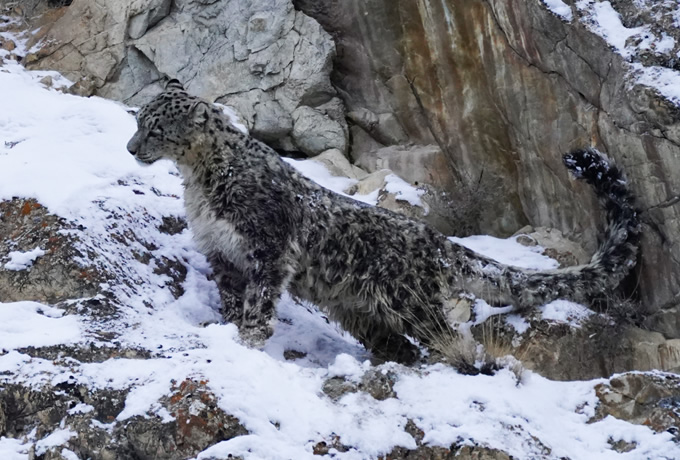
The Snow Leopard is a large carnivore that lives in the highlands of Asia, such as the Himalayas and is nicknamed the “phantom” because it is so rare to see it. Recently tours that search for snow leopards have been conducted in Ladakh, India but due to the distance and the low encounter rates, it is still really difficult to observe them.
The areas where snow leopards are the most likely to be observed include the mountainous areas of the Upper Hunza, the KVO Sanctuary (Khunjerab Village Organization buffer zone project), the Khunjerab National Park, and the Chitral Gol National Park. Trekking in these areas where the Himalayan ibex, urial, and markhor live and the livestock graze, one may have a chance to observe the snow leopards.
There are two advantages to looking for snow leopards in Pakistan, compared to other regions.
One is that you can use the Karakoram Highway road, leading to the Khunjerab Pass. This road is about 70km (43 miles) long, from the border town of Sost (elevation about 2,800m/9,186 ft) to Khunjerab Pass (about 4,600m/15,092 ft high), most of which passes through leopard habitat. In the winter, the road on the Khunjerab Pass is usually blocked by heavy snowfall, so there are very few vehicles on the road. This makes it easy to look for fresh footprints of a snow leopard walking on the road, in the early morning. One simply needs to follow these tracks in the snow, and they might be found nearby, due to the narrow valleys. Finding a snow leopard from the road, also means that you can stay nearby in a warm inn in the village, at the foot of the mountain and observe the snow leopards without having to take a long, challenging trek in the snow. This is something that is very much appreciated from the observer’s standpoint
Also, when searching for snow leopards using the Karakoram Highway near the Khunjerab Pass, it is most likely that you will see the snow leopards when they come down into the valley. It is generally said that February to March is the breeding season and it is a little easier to spot them. When there is a lot of snow at the Khunjerab Pass in Pakistan, you will have a better view because that is when the Himalayan ibex, the prey of the snow leopards, comes down from the higher altitudes.
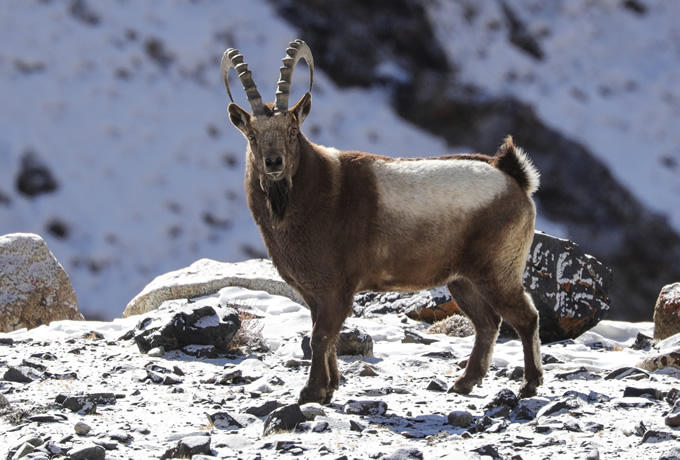
Alpine Ibex are a species of wild goat, found in the areas of the European Alps to the Arabian Peninsula, in Central Asia to India, and Siberia. The subspecies that are observed in northern Pakistan are called Himalayan Ibex, Carpa sibirica sakeen.
They prefer the steep rocky mountainous habitats in the high altitudes, and can to go over 5,000m (16,404 ft) in elevation. In Pakistan, they can be observed from the Karakoram Highway in the Upper Hunza region. Different seasons bring the Himalayan Ibex down from the high elevations for easier observation at Khunjerab National Park. You may find them in the winter during breeding season, in the spring when the new shoots are sprouting, and in the autumn when fruits ripen, they will come down to 3,000m (9,843 ft) elevation.
Thanks to the KVO (Khunjerab Villagers Organization) in each village, illegal hunting is banned, and strictly controlled trophy hunting programs are being carried out in the managed areas. This has helped the populations to increase gradually.
If you are planning to travel to Pakistan for wildlife observation, you will not want to miss seeing the markhor. This family of goats have very unique large, spiraled and elongated horns, and are symbolic as the national animal of Pakistan. They are mainly found in the mountainous regions of Afghanistan and Pakistan and are divided into several subspecies, according to their distribution and habitat type.
Winter is the breeding season for markhor. Normally, the males and females are separate, but during breeding season, males will come down to lower-altitude areas in search of herds of females. Markhor males, are usually very difficult to see during other times of the year, but it might be more likely to see them in December - January. And if you are extremely lucky, you might even get to see the males fight each other in a dynamic display of head butting.
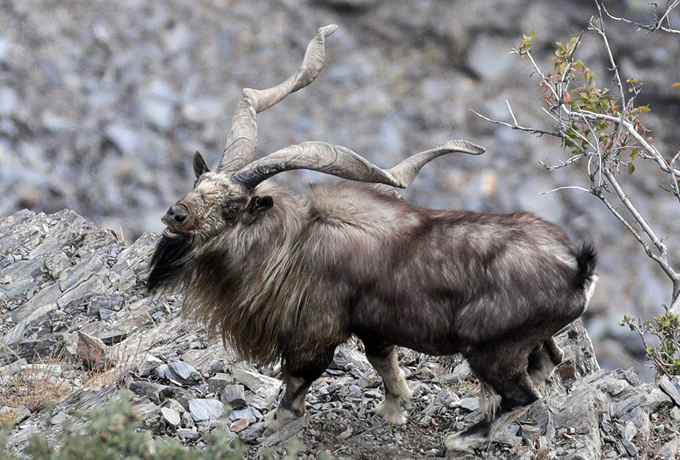
If you want to observe the Kashmir Markhor, the best place to try is Chitral Gol National Park. Many large males tend to congregate here. They are not hunted here, due to being a National Park so they are less wary of humans and you can enjoy seeing their natural behavior at a closer range. There is also the added benefit of having an exceptional view of the Hindu Kush Mountain range. They can be observed in the Tooshi-Shasha Conservancy and the Gahirat (Gehret) Goleen Conservancy as well.
These markhor have a less spiraled rotation of the corners of their horns, which extend out wider, compared to other markhor. They can be seen in the Astor Valley.
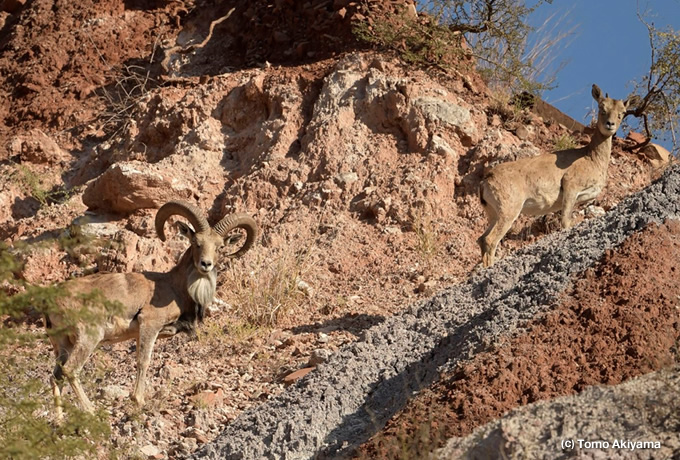
Urial are a wild sheep species, where the males have large horns curled upwards in an arc and long tufts of hair hanging from their neck. They live in the mountainous areas of South and Central Asia. In the past, they were considered the same species as the Ladakh Urial, but in the 2016 issue of “Bovids of the World,” the Punjab Urial of Pakistan became an independent species. With only 800 to 1,000 left in the world, they are an endangered species.
The Punjab Urial inhabit only the Salt Range and Kala Chitta Range, between the Jhelum and Indus Rivers in Punjab. It is possible to make a day trip from Islamabad to see them. There was a sharp decline in their population in the past, due to loss of habitat caused by livestock overgrazing as well as the herds being divided by the construction of the highway. However, the populations have started to make a recovery thanks to the efforts of the CBO (Community Based Organizations) in Punjab. These areas managed by the CBO are another place where one might see the Punjab Urial.
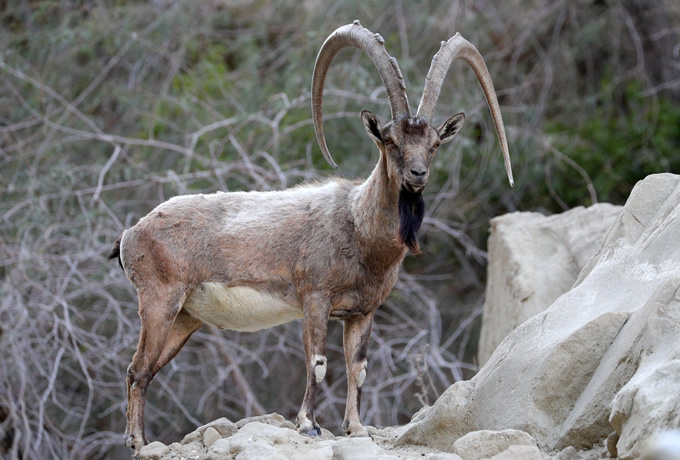
This species of goat is thought to be the ancestors of what is the modern domestic goat. In English, the name is Wild Goat, and in Japanese it is called “Pasan.” In Pakistan’s Chiltan National Park, there is a species called the Chiltan Goat Chilatan aegagrus chialtanensis, which is thought to be the result of a cross between the Wild Goat and the markhor.
Sindh Ibex can be observed in Kirthar National Park, which is also close to the Arabian Sea. Seeing the herd of male Ibex with their massive horns, against the beautiful rocky desert landscape is a spectacular sight. It is important to approach them quietly, as they have a very strong fear of people, and will only look comfortable from at least about 800 meters (2,625 ft).
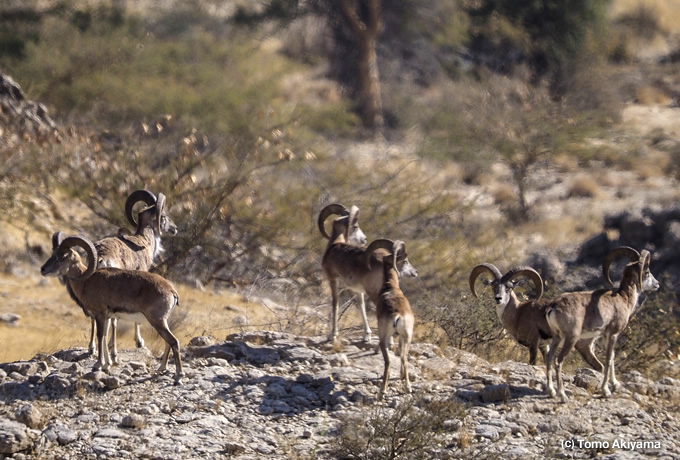
What is thought to be the genetic ancestor of the modern domestic sheep, also called Mouflon, is a wild sheep that used to be considered one species that lived from Europe to the Himalayas. It was later classified that a subspecies that inhabits the eastern Himalayas became recognized as the Urial, and still later, it ended up being categorized as an independent species. However, it is very difficult to know where the line is to separate out the classification of the Mouflon versus the wild sheep which live in the western parts of Pakistan near the Arabian Sea. However, in a publication of the 2016 issue of “Bovids of the World” there was clarification that the wild sheep, Afghan urial, inhabits the ranges of Iran, Iraq, Turkmenistan, Afghanistan to the Pakistani state of Sindh.
Afghan urials and Sindh ibex can both be observed in Kirthar National Park. The Afghan Urials main habitat is on gentler slopes, compared to the Sindh Ibex which live among steeper cliffs.
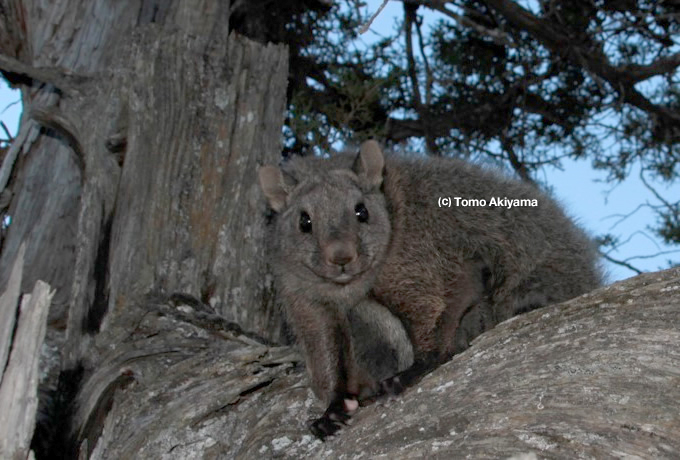
In 1911, this species was listed with only 11 furs recorded, but was thought to be extinct for a long time until its rediscovery in 1995 (which had been observed locally, of course, but just had not been reported). It is the largest flying squirrel in the world but had never been observed alive. Due to bad record-keeping the source of the original pelts was not known until it was found in Pakistan in 1990. Now other closely related species have been discovered in Tibet, and further away in Yunnan, China (two species, the Tibetan and Yunnan woolly flying squirrels.)
With a total length of 1.2 meters (almost 4 ft), this endemic species only lives in Pakistan (some say also in the northwestern parts of India). Mainly they eat the leaves and seeds from coniferous trees. Since they have used the same rock holes for millions of years, the manure of the flying squirrels have become accumulated in the rock cavity, becoming almost fossilized. The material is used as a drug called “Salajit” and it is said to be effective for ailments like joint pain.
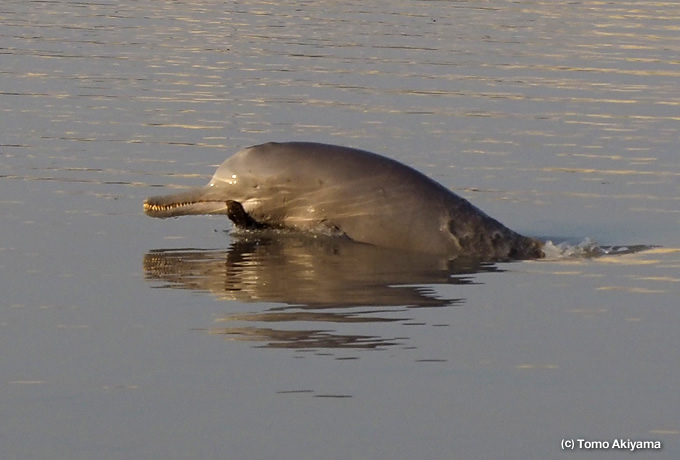
These dolphin live in the Indus River near the Sukkur area. During the construction of the irrigation dam, it was estimated that there were only 1100 to 1400 of them living in a central 97 km section of the river. Recently they have been grouped in the same species category as the Ganges river dolphins. In Sukkur, you can enjoy taking a boat ride to try to maybe catch the river dolphins, but perhaps the best view is from a bridge in Sukkur. Here, you can try to see the dolphins when they come up to the surface to breath. If you watch closely you might even see the narrow, long mouth, that is used for catching fish. Their eyes are not functional, so they use echolocation for navigating around objects underwater and for catching prey.
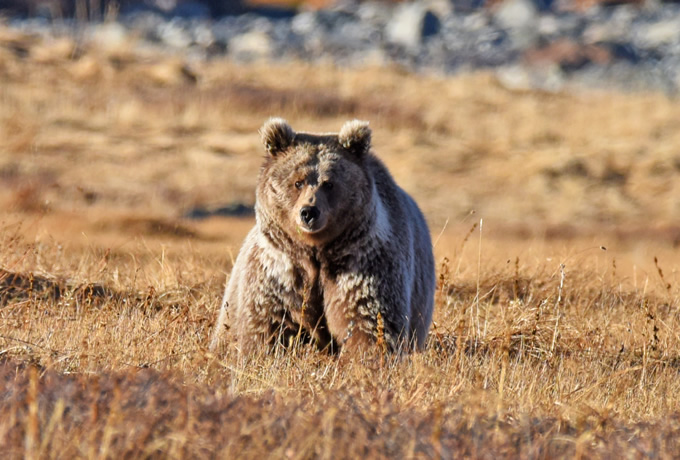
This brown bear subspecies lives in and around the Himalayas. They originally inhabited larger areas of Nepal, Tibet, Northern India and Northern Pakistan, but their population sharply declined due to loss of habitat, excessive trophy hunting, and people traded their coveted fur and organs for use in Asian medicine. It is said that now only about 150-200 of them remain in Pakistan, and worldwide, only about 1,000 remain.
Deosai National Park in Pakistan is a high-altitude plateau with an average of 4,100 meters (13,451 ft) elevation and is one of the places these rare bears can be seen. In 1993, the Park was established to protect the Himalayan Brown Bears, whose populations were plummeting. The bears leave their hibernation dens around May, and they can be seen grazing in the Plateau in the summer month, and occasionally hunting marmots in the fields.
For exploring the lesser-known wildlife of Pakistan, we present these Indus Caravan Wildlife Tours. Each program is crafted for you with carefully made observations, and through meetings with each local community. At the “Top of the World” where the mountainous regions of the Himalayas, Karakorum, and Hindu Kush meet, you can possibly encounter wildlife like the Himalayan Brown Bear, Markhor, Ibex, or the Snow Leopard.
Meet the “King of Wild Goats” by heading to the foot of the Hindu Kush Mountains to seek the male Markhor. Herds of females and young males can be observed year-around, but the males with their impressive horns can be more easily observed, once they descend from the highlands in search of females. If you are lucky you may even get to see the male’s competition battles with dynamic head-butting that only happens during this season. Also, the spectacular view of the Tirich Mir (7,708m/ 25,289 ft), the highest peak in Hindu Kush will be seen during the tour.
| Sample Itineraries | |
| Day01 | From Islamabad to Chitral or Ayun |
| Day02 | Tooshi-Shasha Conservancy: Observing and photos of Markhor |
| Day03 | Chitral Gol National Park: Observing and photos of Markhor |
| Day04 | Continue wildlife observations at Chitral Gol NP |
| Day05 | Travel from Chitral or Ayun returning to Islamabad |
Schedule:Starting from Islamabad, arrangements can be made starting from 4 days, 3 nights. It is recommended to plan at least 2 full days for observation time, in order to improve the chance for the best wildlife encounters.
Note
※Please feel free to contact us. We will confirm the travel dates, the number of participants, your preferences on the accommodations, etc and provide an estimate based on your customized plan.
※From Chitral (Ayun), we can add optional visits to Gahirat Goleen Conservancy and the valleys of the Kalash villages (Bomburet, or Rumbur).
Visit the Hunza’s Khunjerab National Park, the home of the wildlife that is called a “Phantom,” the Snow Leopard. When the Ibex come down to the lower elevations, around 3,000-4,500 meters, the snow leopards will follow them down into the valley. Start the early morning with searching the ground for fresh tracks of the snow leopards, in the areas nearby. Sometimes we also find signs of a fresh kill. The view of the Karakoram Mountain Range and the frozen Pamir River in the wintertime can be strikingly beautiful.
| Sample Itineraries | |
| Day01 | Travel From Islamabad to Chilas |
| Day02 | Travel From Chilas to Upper Hunza |
| Day03 | Khunjerab National Park, Upper Hunza Valley: Observation & photography |
| Day04 | Upper Hunza, Khunjerab National Park: Observation & photography |
| Day05 | Continue Wildlife observations & photography |
| Day06 | Continue Wildlife observations & photography |
| Day07 | Continue Wildlife observations & photography |
| Day08 | Continue Wildlife observations & photography |
| Day09 | Continue Wildlife observations & photography |
| Day10 | Travel From Upper Hunza to return to Chilas |
| Day11 | Travel From Chilas returning to Islamabad |
Schedule:It takes time to encounter a snow leopard. If lucky the sighting may only take a day or two, but basically, it is recommended to set aside a week or more to increase your chances to get the best sightings of a snow leopard.
Note
※Please inquire. We will confirm the travel dates, the number of participants, your preferences on the accommodations and provide an estimate based on your customized plan.
※We will mainly be using a vehicle to search for Snow Leopards. If you wish, we can also camp (using a portable grazing hut) in a valley where the snow leopards are likely to be observed by trekking.
※We will be at an elevation of 3,000 to 4,500 meters, and caution is needed to prevent altitude sickness. In addition, the temperatures drop significantly in December to March, so you will need to wear warm clothes and shoes appropriate for outdoor wildlife observations. Domestic flights from Islamabad to Gilgit are also available, but it is usually recommended to use the Karakoram Highway and travel by land due to the reduced number of flights in the winter, and for the logistics of transportation of scopes and photography equipment. Please contact us as soon as possible, to secure a specialist snow leopard guide.
The Deosai Plateau is called the “Flower Park in the Sky” because in the summer, the ground is carpeted with wildflowers and wildlife such as Long-tailed Marmots, enjoy the short season. Around May, the brown bears will leave their dens after a long hibernation and can be seen on the Plateau. Enjoy camping and trekking at an elevation of 4,000 meters while enjoying the wildlife and photography!
| Sample Itineraries | |
| Day01 | Travel From Islamabad to Skardu by Air |
| Day02 | Travel From Skardu to Deosai National Park. Camping at the Plateau. |
| Day03 | Deosai National Park: Wildlife observation & photography |
| Day04 | Continue wildlife observation & photography |
| Day05 | Continue wildlife observation & photography |
| Day06 | Travel From Deosai Plateau to Skardu |
| Day07 | Travel by air From Skardu to Islamabad. Or if traveling by land, to Hunza |
Schedule:It is recommended to allow for at least 3 days for Himalayan brown bear observations on the Deosai Plateau. There are various routes to get to the Plateau, which can be combined with other sightseeing areas in the Northern Pakistan.
Note
※Please inquire. We will confirm the travel dates, the number of participants, your route preferences and the type of accommodations, and provide an estimate based on your customized plan. When camping at the Deosai National Park, the reservation includes the campsite, guide, cook, and coordination with the Park Ranger is required.
※Himalayan Brown Bears can only rarely be observed from the roads, so the best way to view them is by trekking. Since the Plateau is at an elevation of above 4,000 meters, you will need to be prepared to have a high level of physical fitness for the hiking. We can arrange for a porter for camera gear if needed.
※Trekking and accommodations (Camp) will be at an elevation of 4,000 meters, so there is a risk of altitude sickness. Even in the summer months, the temperature drops below freezing in the early morning hours and in the autumn, the temperatures will go significantly lower. Compared to in the past, the domestic flights from Islamabad to Skardu have improved on the number of flights, but these mountain flights can be cancelled due to bad weather. If traveling by road to Skardu, please account for two travel days from Islamabad when scheduling.
Endemic to Pakistan (Punjab State), the Punjab Urial lives on the Punjab Plain of the Salt Range CBO Reserve. Their numbers have been increasing in recent years. It is possible to see them in a day trip from Islamabad.
| Sample Itineraries |
| You can observe them, taking a day trip from Islamabad. An early morning departure for the CBO(Community Based Organization)reserves in the Salt Range. Return to Islamabad at night. Note ※Please inquire. According to the travel dates, number of people, and other requests, we will make a customized itinerary and estimate. ※This will mostly be a tour conducted by vehicle, driving through the reserve. There might be some hiking on rocks, according to where the urial have been found. |
This is the place where the desert plateau meets the limestone plateaus, Kirthar National Park. Using the rest house in the park as a base camp, we will go looking for wildlife in the surrounding desert mountains, such as herds of Sindh Ibex or Afghan Urial, or the Chinkara. Since the wildlife here is protected, seeing them is much easier and there are many opportunities for bird watching.
| Sample Itineraries | |
| Day01 | Travel From Karachi to Kirthar National Park. Staying at the Rest house within the park. |
| Day02 | Kirthal National Park: Wildlife observation & photography |
| Day03 | Continue wildlife observation & photography |
| Day04 | Continue wildlife observation & photography |
| Day05 | Travel From Kirthal National Park returning to Karachi |
Schedule:It is recommended to have at least two days for wildlife observations to increase the chance to see the Singh Ibex and Afghan Urial in the Krithal NP.
Note
※Please Inquire. We will confirm the travel dates, the number of participants, your preferences on the accommodations, and provide an estimate based on your customized plan. Included in the Rest house accommodations, is a guide, cook, and coordination with a Park ranger for the camp management.
Spectacular coastal regions and dramatic scenes with mud volcanoes and of course, adventures to see Balochistan’s wildlife will be the goal of this tour. Setting up a base camp at the coast, you will have the opportunity to head out to see the mountains and coast of Hingol NP every day you are there. In the national park, you may encounter wildlife such as Sindh Ibex and Gujarat Chinkara. Birds of prey such as the Imperial Eagle, Long-legged Buzzard, and Common Kestrel might be observed in the desert areas, and seabirds such as the Western Reef Egret and the Great White Pelican may be seen along the coast. The Mugger Crocodile on the Hingol River might also be visible. You can enjoy not only encounters with wild creatures, but take in the nature through camping, mud volcano walks and coastline drives.
| Sample Itineraries | |
| Day01 | Travel From Karachi to Kund Malir. Set up the coastal base camp. |
| Day02 | Hingol National Park: Coastal Areas, Exploration of mud volcanoes, and wildlife observation. |
| Day03 | Continue seeing and photographing the wildlife, the coastal areas, and more of Hingol NP |
| Day04 | Continue seeing and photographing the wildlife, the coastal areas, and more of Hingol NP |
| Day05 | Travel From Kund Malir back to Karachi |
Schedule:Exploring the vast Hingol NP while searching for Sindh Ibex and admiring the unique landscape around the mud volcanoes as well. It is best to avoid the weekends, as that is a time when many tourists visit the coast and your chances of seeing wildlife will be better with less people.
Note
※Please feel free to contact us. We will confirm the travel dates, the number of participants, your preferences on the accommodations, and provide an estimate based on your customized plan. The coastal base camp includes clean toilets and showers, and based on the number of people in your group, can be used privately.
※There is a need to obtain a permit in advance of entering Balochistan. The process can take more than a month, to obtain a permit after getting a visa, and as of 2021, the movements of foreigners are limited, so there will constantly be a police escort to accompany your tour group.